50エキスパートウェアハウスの設計とレイアウトのアイデアとヒント
倉庫のレイアウトを設計することは簡単な作業のように見えますが、実際には非常に複雑です。実際、倉庫の設計とレイアウトは、業務の生産性を左右し、ピッキング時間や労働時間に影響を与え、交通の流れが悪いために安全上のリスクが高まる可能性があります。
50人の専門家による倉庫の設計とレイアウトをまとめました。倉庫の生産性を最適化し、安全性を高めるために施設の理想的なレイアウトを設計するのに役立つアイデア、ヒント、および戦略。以下のリンクをクリックして、特定のセクションのヒントにジャンプしてください:
- 倉庫レイアウト計画のヒント
- 倉庫のレイアウトを設計する際の考慮事項
- 倉庫レイアウトデザインのアイデア
倉庫レイアウト計画のヒント
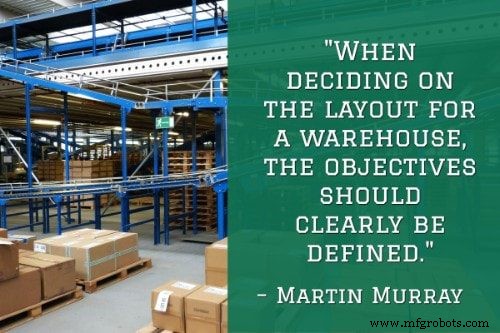
1。計画プロセスを開始する前に、目標を定義してください。 「倉庫のレイアウトを決定するときは、目的を明確に定義する必要があります。目的は、会社の全体的な倉庫戦略と一致している必要があります。目標は、倉庫保管コストの削減や最大の顧客サービスの提供など、高レベルで定義できます。
「同様に、目標は、倉庫スペースの最大化、倉庫の柔軟性の最大化、増加など、より具体的にすることができます。リソースを増やすことなく、倉庫の効率を向上させます。」 – Martin Murray、倉庫レイアウトの計画と最適化–サプライチェーンへの影響 、バランススモールビジネス; Twitter:@thebalance
2。お住まいの地域の建築基準法を知ってください。 「倉庫製品の保管に関する地域の建築基準をよく理解してください。たとえば、パレット積載物の上部からスプリンクラーヘッドまでに必要な最小のクリアランスはどれくらいですか?あなたの倉庫は、特別な設計上の考慮が必要な地震地域にありますか?出口の経路、フォークリフトの通路と徒歩の通行など、安全上の考慮事項に注意してください。」 – Kim Stebbins、倉庫のレイアウトと設計:パレットラックを注文する前に知っておくべきこと 、次のレベルのストレージソリューション; Twitter:@NextLevelMHE
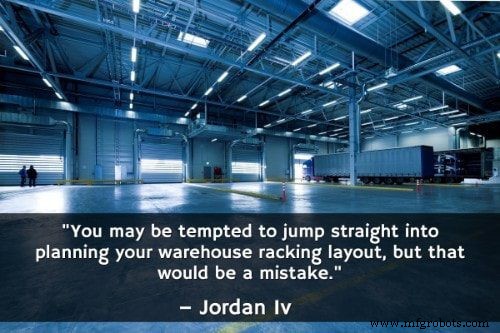
3。上司や請負業者に意見を求めましょう。 「倉庫のラックレイアウトの計画に直接飛び込みたくなるかもしれませんが、それは間違いです。始める前に、知識のある請負業者(マテリアルハンドリング会社など)、倉庫管理者、さらには運転手に相談してください。彼らは、特定の倉庫での経験は言うまでもなく、倉庫施設の運用と計画に長年の経験があります。目標と要件を説明してから、その提案に耳を傾けてください。」 –ジョーダンIV、倉庫ラックレイアウトの設計方法:効率的な計画への10のステップ 、LinkedIn
4。倉庫管理システム(WMS)の履歴データを利用します。 WMSをお持ちでない場合は、今が投資を行う絶好の機会です。 「今日の競争の激しいビジネス環境では、データ収集が不可欠です。今日の倉庫管理システム(WMS)は、在庫を追跡するだけでなく、重要な運用データを収集します。多くの場合、WMSは、製品スロットの哲学を従来の製品価値ベースのABC分類から、フローティング在庫倉庫レイアウトなどの直感に反するが非常に効率的なアプローチに変更するなど、根本的な推奨を行うことができます。
「実装することをお勧めします。ダウンストリームエラーを回避するための自動化された資産追跡データ収集方法—手動入力はノーノーです。さらに一歩進んで、アセットに一意の追跡番号を割り当てます。シリアル番号(多くの場合、一意ではない)に依存しないでください。また、動産を追跡するだけでなく、固定資産も追跡します。」 – Cody Adams、究極の倉庫設計とレイアウトのための13のヒント 、Formaspace; Twitter:@RealFormaspace
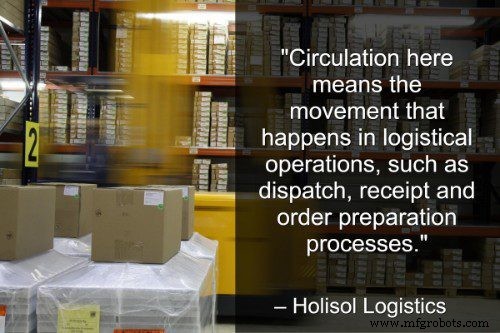
5。商品が施設内をどのように循環しているかを理解します。 「ここでの循環とは、発送、受領、注文準備プロセスなどのロジスティクス業務で発生する動きを意味します。製品のローテーションとは、商品が更新される頻度です。つまり、高回転の製品とは、入出力の割合が高い製品のことです。荷物の移動にはコストがかかるため、会社の運用手順で認められている場合は、移動を最小限に抑えることをお勧めします。これらのフローを検出することは、効果的な倉庫設計に必要なものを定義するのに役立つため、非常に重要です。」 –完璧な倉庫設計のための5つの要素 、Holisol Logistics; Twitter:@HolisolLogistic
6。倉庫のさまざまな領域間の空間的関係を決定します。 「プロジェクトが明確に定義されたら、プロセスの第2フェーズは、倉庫のエリアをレイアウトするための全体的な計画を作成することを目的としています。このステップでは、レイアウトの非常に具体的な詳細は意図的に無視されます。ただし、レイアウトの他の側面は綿密に評価されます。
「このフェーズを開始する最も論理的な方法は、倉庫のエリア間の空間的関係を決定することです。エリア間の関係を描く際に考慮しなければならない多くの側面があります。いずれか1つの要因の重要性と影響を誇張または過小評価すると、倉庫の流れに悪影響を与える可能性があります。私たちのコンサルティングチームは、論理的な評価システムを使用してこの問題を解決します。
「このフェーズの次のステップは、各エリアに必要なスペースの量を決定することです。このタスクを実行するには、いくつかの方法があります。特定の状況では、特定の方法が他の方法よりもうまく機能する場合があります。たとえば、施設にはレイアウトするエリアの履歴情報がない場合もあれば、スペース基準を確立している場合もあります。
「スペース要件を設定した後、制限を考慮して調整を行うことができます。各エリアの特定のニーズ。たとえば、一部のエリアには出口ドアが必要な場合があり、他のエリアにより多くの通路スペースを与えることが理にかなっている場合があります。」 – Marvin Logan、より良い倉庫レイアウトを作成する方法 、バスティアンソリューション; Twitter:@BastianSolution
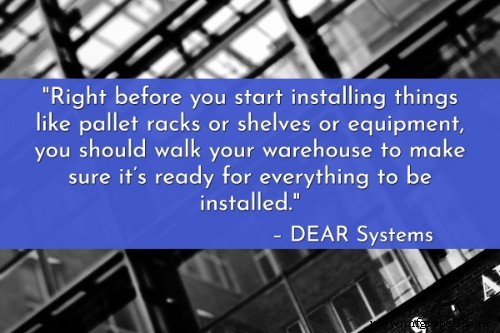
7。新しい棚やラックの設置を開始する前に、レイアウト設計をテストしてください。 「パレットラック、棚、機器などの設置を開始する直前に、倉庫を歩いてすべてを設置する準備ができていることを確認する必要があります。
「マスキングテープを使用して、主要な作業領域の輪郭を描き、物を運びます。パレットジャッキを転がして、他の従業員に同時に作業をシミュレートしてもらいます。
「これにより、スペースが最適化されているかどうかを視覚的に理解できます。ここでエラーが発生すると、後でエラーが悪化します。」 –倉庫のレイアウト設計を効果的に計画するための4つのヒント 、DEAR Systems; Twitter:@DearInventory
8。回路図から始めます。 「優れた倉庫レイアウトは、スペースのサイズに関係なく、常に最初にすべてを紙に書き留めることから始まります。これを行う最も簡単な方法は、特にスペースが大きい場合や標準の長方形ではない場合に、倉庫の設計図のコピーを使用することです。賃貸している場合は、家主が提供できる可能性があります。
「青写真を手に入れることができない場合は、方眼紙に独自の倉庫の概略図を簡単に作成できます。私は通常、回路図面で1平方=1平方フィートを使用します。
「縮尺どおりに測定値が描かれた印刷またはオンラインの回路図面を作成したら、柱や支柱、オフィスエリアの増築、設置された機器などの固定機能に注意してください。 、頭上のドアなど、回避する必要があります。
「私の倉庫では、オフィスの増築により、計画しなければならない中央からチャンクが取り出されます。オフィスのドアが倉庫に向かって開いているので、誤ってブロックすることはありません。さらに、出荷作業として、頭上のドアの位置が出荷と受け取りのワークフローの鍵となるので、それらの用途に注意します。
「主要な機能が記載された回路図の準備ができたら、開始します。スペースを計画します。」– Krista Fabregas、倉庫レイアウトの計画–効率的な保管、梱包、配送エリアの設定方法 、FitSmallBusiness.com; Twitter:@FitSmallBiz
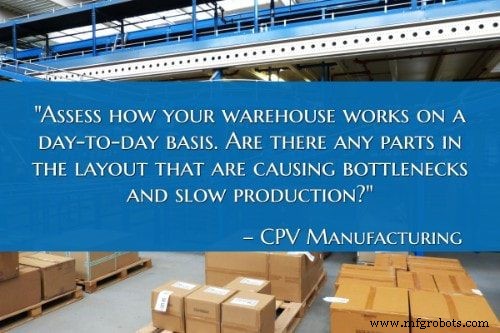
9。プロセスマップを作成します。 「倉庫が日常的にどのように機能しているかを評価します。ボトルネックや生産の遅延を引き起こしているレイアウトの部分はありますか?その場合は、スムーズで効率的なワークフローを確保するために、倉庫のレイアウトを最適化する必要があります。
「施設が現在どのように稼働しているか、各ゾーンがどこにあるかを詳細に示すプロセスマップを作成します。次に、変更が必要な領域を選択します。
「次に、レイアウトを変更して新しいプロセスマップを作成します。たとえば、生産と梱包のボトルネックに気付いた場合、新しいプロセスマップでは、生産の需要に簡単に対応できるように梱包ゾーンが移動される可能性があります。」 – 費用対効果の高い倉庫を設計する方法:倉庫のレイアウト設計を最適化する 、CPV製造; Twitter:@cpvmfg
10。プロセスに加えて、在庫を深く理解する必要があります。 「作業プロセスを理解するとともに、そこに保管される在庫を理解する必要があります。このためには、これらのアイテムのサイズと形状、これらのアイテムを輸送するために必要なマテリアルハンドリング機器、および保管する各アイテムの総量を知る必要があります。これはさまざまな理由で重要になります。
「まず、アイテムのサイズが重要になります。これらのアイテムが占めるスペースが多いほど、同じアイテムであろうと、他の在庫のスペースが少なくなるためです。それ以外は。あなたが倉庫を運営しているとき、各平方フィートはあなたにお金がかかるので、これは重要です。また、それぞれを移動するために必要なマテリアルハンドリング機器を調べることは、在庫保管の間に必要な車線の幅に影響を与えます。明らかに、フォークリフトやその他の重機を必要とするアイテムは、より広い車線を必要とします。ただし、施設内の従業員の全体的な安全を確保するために、その地域の全体的な歩行者数も考慮する必要があります。」 – 倉庫計画ガイド:スペースの活用 、Panel Built、Incorporated; Twitter:@PanelBuilt
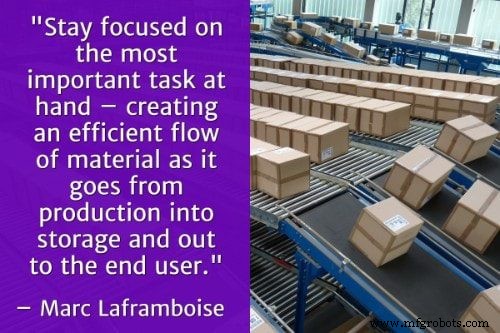
11。今のところ、倉庫のレイアウトを設計するだけではありません。また、将来予測される成長に対応する追加の設計を作成する必要があります。 「倉庫レイアウトデザインの作成に関する私の経験は、過密な既存のスペースから、方向性を模索している完全に空の建物まで多岐にわたります。両方についての私の最初の推奨事項は、アイデアと概念を紙に書くことです。
「確かに、倉庫レイアウトの非常にシャープなAutoCAD 3Dデザインがあるのは素晴らしいことですが、基本から始めて、紙に鉛筆。手元にある最も重要なタスクに集中し続けます。生産から保管、そしてエンドユーザーに至るまでの効率的なロジスティクスフローを作成します。
「適切な機器、ストレージメディア、および十分なスペース–しかし、それはすべて、急速な成長に耐えるように設計されているかどうかにかかっています。将来の成長を予測し、今のところデザインを作成するだけでなく、将来のために他のいくつかのデザインを作成してみてください。」 – Marc Laframboise、倉庫のレイアウトデザイン 、マテリアルハンドラー; Twitter:@ MaterialH4ndler
12。適切な照明をおろそかにしないでください。 「倉庫の照明が不十分だと、労働者は、適切な照明計画が実施されていればすぐに見られるアイテムを探すのに不必要な時間を費やすことになります。作業者の生産性が低いことに加えて、照明が不十分だと、通路をまたがる交通やトリップの危険など、潜在的な危険の視認性が低下するため、安全上の問題が発生する可能性があります。小さなラベルのアイテムを収容する場所は、大きなラベルのアイテムを収容するエリアよりも多くの照明を必要とします。」 – Justin Johnson、製造倉庫レイアウトのベストプラクティス 、クロニクル; Twitter:@HoustonChron
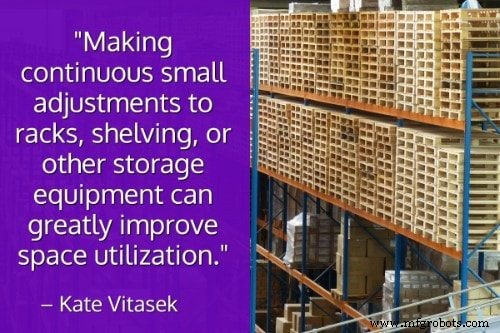
13。倉庫のレイアウトとプロセスを定期的に確認して、非効率性を特定します。 「ほとんどの企業は、倉庫の初期レイアウトに多大な労力を費やしています。ただし、業界の調査によると、半数の企業がレイアウトを確認するための継続的なプロセスを実施していないことがわかります。ストレージ領域がどのように構成されているかを確認し、製品構成の変更に応じてストレージ領域を再構成するプロセスを導入することはベストプラクティスと見なされ、高レベルのスペース使用率と効率を維持するために重要です。ラック、棚、またはその他の保管機器を継続的に微調整することで、スペースの使用率を大幅に向上させることができます。
「すべての倉庫保管ソフトウェアはデータで実行されるため、製品と保管場所のデータを最新かつ正確に保つ必要があります。ベストプラクティス企業は、すべての情報を単一の記録システムに保持し、最新かつ正確に保ちます。製品データには、キューブデータ、ロット/シリアル番号情報、および特別な要件を含むすべての製品特性が含まれている必要があります。これにより、製品を特別な保管場所に送ることができます。臭気の移動や火災の危険性があるアイテム、または温度管理が必要なアイテムを分離するために、特別な保管場所を使用できます。高価値の製品には、ケージまたはアクセス制御されたストレージが必要になる場合があります。」 – Kate Vitasek、ストレージと在庫管理のベストプラクティス 、マルチチャネルマーチャント; Twitter:@mcmerchant
14。既存の倉庫レイアウトを再設計する場合は、すぐに行う必要のある変更と、実装に時間がかかる変更を決定します。 「変更を開始することを決定したら、どの変更をすぐに開始して3〜6か月以内に完了する必要があり、どの変更を実装して完了するのに時間がかかるかを特定します。どのアクションアイテムが資本集約的であるかを判断することも同様に重要です。これらは必要な場合も二次的な場合もありますが、長期的には必要になります。」 –施設の容量を増やす方法を特定するための倉庫評価 、F。Curtis Barry&Company; Twitter:@FCurtisBarryCo
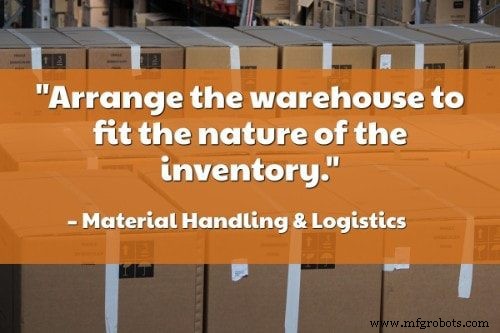
15。簡単なスプレッドシート分析により、さまざまな深さの行数と必要なラック数を把握できます。 「在庫の性質に合うように倉庫を配置します。少数のSKUを大量に保存する場合は、多くの深い行が必要です。在庫が少量の多数のSKUである場合は、多くの面を持つ浅い列がより実用的です。
「単純なスプレッドシート分析では、さまざまな深さの列の数と必要なラックの数を計算します。これから、保管と通路に必要な面積を計算します。ドック、オフィス、および将来の拡張のためのスペースは含まれていません。
「分析は、現在の在庫の「スナップショット」に基づいており、将来の変更を含むように変更されています。個々のSKUは週ごとに異なる場合がありますが、深い行と浅い行の組み合わせは驚くほど安定しており、1つの期間が非常に代表的です。積み重ねることができる高さのパレットは、製品の重量、パッケージの強度、建物の高さなどによって異なります。」 –倉庫の計画 、マテリアルハンドリングとロジスティクス
16。施設が取り扱うSKU(および製品の種類)の数に基づいて、適切なドックと受け取りスペースを計画します。 「適切な場所を見つけた後、または既存の施設を改造する場合は、設計段階に直接進み、運用データを評価して、施設の目標に関する洞察を得ます。このデータを使用して、毎日の生産と受け取りのサイクルを分析します。また、このデータを使用して、1日を通して変化する在庫レベルを説明します。この情報は、プロセスを高速化し、ワークスペース全体のフローを作成するレイアウトを作成するのに役立ちます。製品がどこから来ているのか、どこに保管されているのか、施設内を移動する頻度を知ることで、スペースを賢く使用するデザインを作成できます。
「レイアウトデザインの主要コンポーネントの1つはさまざまなタイプのパレット積載に対応する能力を最適化します。一部の倉庫では、1つのSKUで1つのパレットを処理します。これにより、受け取りと保管が簡単になります。ただし、他の倉庫では、大量の化学物質やその他の物質を処理します。これらの物質は、保管する前に検疫およびテストする必要があります。 1つのSKUでパレットを処理する場合でも1000で処理する場合でも、操作をサポートできる受け取りエリアを設計します。十分なドックと受け取りスペースがあることを確認します。」 –レイアウトデザイン 、Warehouse1; Twitter:@ Warehouse1
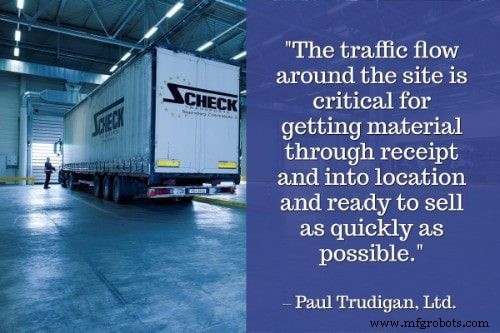
17。スロット分析を実行します。 「これで、製品カテゴリ、速度、および測定単位によって在庫を分離したので、次の段階は、在庫のバランスをとるためにスロット分析を実行することです。スロットリングは、すべてのフォワードピックおよびリザーブロケーションの数量とサイズを定義するプロセスです。これは、製品カテゴリ、速度、およびフォワードピックの場所に配置する測定単位の最適な組み合わせ、および速度ごとに各製品カテゴリの予備在庫を保存する場所を分析することによって決定されます。在庫の各測定単位のすべての製品の寸法と立方体の体積を設定することが重要です。ピックフェースのサイズを決定するときは、在庫とピッキングおよび補充のバランスを取ることが重要です。ピックフェースの大きさを決定するには、キューブ、速度、および各製品グループと速度の組み合わせを補充する回数を分析します。」 – Victor Coronado、スペースと効率を最大化するための倉庫の最適化 、LinkedIn
18。最終決定を下す前に、いくつかのレイアウト(内部および外部レイアウトを含む)を描画し、それらを検証することをお勧めします。 「以前の決定が段階的に廃止されると、設計プロセスの重要な部分が始まります。それは、可能なレイアウトの準備です。ただし、内部レイアウトと外部レイアウトを区別することが重要です。一方では、外部レイアウトは、倉庫エリアが配置される場所と、関連する道路および駐車場を示します。重要な決定の1つは、倉庫エリア周辺のトラフィックを決定することです。一方、内部レイアウトには、分割されるさまざまな領域、ドック領域の場所、および必要なドックの数が含まれます。これには、最大の流れのために距離が短いエリア間の分類が含まれます。内部レイアウトは、次の目的を満たす必要があります。
- スループット効率
- 建物の利用率
- 安全性
- 環境面
「可能なレイアウトを描いた後、それらを検証する必要があります。この検証は、レイアウトがフレームワークの最初のステップで提案された要件を満たしていることを確認しながら、運用上および技術上の実現可能性の観点に従って行う必要があります。最後に、優先レイアウトを選択する必要があります。そのために、考えられるすべてのレイアウトがまとめられ、定量的(例:財務コスト)と定性的(例:SWOT分析)の両方でさまざまな結論が導き出されます。結局のところ、会社の活動と期待に最も合うデザインを選択することが可能です。」 – BeatrizdelRíoTomé、倉庫内のロジスティクス設計:S:tEriksの場合 、ルンド大学; Twitter:@lunduniversity
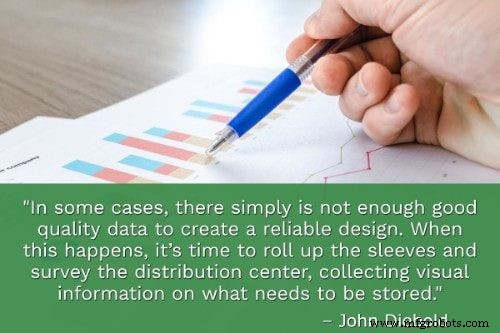
19。データが足りませんか?調査を実施します。 「場合によっては、信頼できる設計を作成するのに十分な高品質のデータがないだけです。これが発生した場合は、袖をまくり上げて配送センターを調査し、何を保管する必要があるかについての視覚的な情報を収集します。この情報を収集するために使用できる一般的な方法は4つあります。
- 方法1:製品キューブ:製品ディメンションのデータベースを使用します。
- 方法2:ストレージキューブの調査:配送センターの各ビンの各アイテムを調査します。 SKU番号を記録し、配送センターでそのSKUが占めるスペースの量に関する情報を収集します。
- 方法3:ビンキューブを利用する(ビンごと):各ビンの寸法を測定し、製品が占める各ビンのスペースの大まかな割合を取得します。これはSKU固有の方法ではありません。
- 方法4:ビンキューブを利用する(集計):各ビンの寸法を測定し、各ビンタイプに適用される一般的な利用率を決定します。これはSKU固有の方法ではありません。」 – John Diebold、不完全なデータを使用した倉庫レイアウトの計画 、連邦サプライチェーンアドバイザー
倉庫レイアウトを設計する際の考慮事項
20。新しい(より効率的な)レイアウトは、ROIに直接影響を与える可能性があります。 「ROI(投資収益率)は、倉庫のレイアウトの変更や施設全体の再設計を検討する際の重要な要素です。通路が混雑していると、時間と効率が失われる可能性があります。非効率性は、主要なピック場所で在庫切れを引き起こす可能性があり、これは運用を損ない、費用がかかります。追加のオフサイト倉庫スペースを借りることによってもお金が無駄になる可能性があります。これらの要因を解決することで、建物、ラック、フォークリフトへの損傷を減らすことは言うまでもなく、運用コストの削減と収益の改善に貢献できます。」 –専門の倉庫コンサルタントを使用した倉庫最適化のガイド 、アーバーマテリアルハンドリング; Twitter:@AMH_inc

21。トラフィックフローは、倉庫のレイアウト設計において重要な考慮事項です。 「これは倉庫設計の明らかな焦点のように聞こえるかもしれませんが、建物の平方フィートを最大化するために、定期的に見落とされたり、妥協されたりしています。サイト周辺の交通流は、資材を受け取りから場所に運び、できるだけ早く販売する準備をするために重要です。英国の工業団地に行くと、荷降ろしのためにサイトにアクセスできるようになるのを待っているトラックが公道に停車しているのがわかります。この待ち時間は、滞納と注文の遅延や売り上げの損失の可能性の両方で企業にお金をかけます。外部レイアウトと交通流が、商品を可能な限り迅速に受け取り、荷降ろしし、発送するのに十分であることを確認する必要があります。
「効率的な交通流は、倉庫のレイアウトと適切な構成に適切な数のベイを組み込むことから始まります。ベイの。操作のタイプに応じて、レベルアクセスベイとドックレベルベイを組み合わせる必要があります。たとえば、eコマースの運用では、カーテンサイドのトレーラーに材料が入り、側面から荷降ろしして、水平なアクセスベイから倉庫に入る必要があります。ただし、発送の場合、注文はリアローディングを必要とする剛性の高い車両に発送される可能性があり、その結果、ドックレベルのベイになります。」 – 倉庫の設計–成功のための5つのヒント 、Paul Trudigan、Ltd .; Twitter:@paul_trudigan
22。安全性と人間工学を念頭に置いて設計してください。 「倉庫の安全を確保することは、事故を減らし、ビジネスとしてのコストを増やすことを意味するだけではありません。また、運用をよりスムーズかつ効率的に実行するのにも役立ちます。
「倉庫の安全性に関する以前のブログ投稿では、スタッフが曲げたり、伸ばしたり、ねじったりする必要のある量を最小限に抑えるように倉庫を設計することで、作業を改善する方法について説明しました。 、怪我のリスクなし。在庫を複数回移動する必要がないことを確認することも役立ちます。」 –倉庫のレイアウト設計を改善する4つの方法 、ケリッジ; Twitter:@KerridgeCS
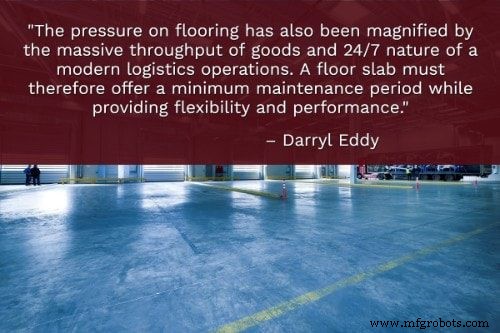
23。フローリングは、実際には倉庫の運営に大きな影響を与える可能性のある考慮事項です。 「現代の建築技術により、倉庫のフローリングの重要性が高まっていることは間違いありません。床スラブの品質と耐久性は、倉庫内のプロセスのすべての要素に、良いか悪いかにかかわらず影響を与える可能性があります。 「多くの倉庫およびロジスティクス事業者が、より大きくより高い建物を必要とすることが多い新技術を最大限に活用しているため、より平坦な床の需要が大幅に高まっています」と、TwintecIndustrialFlooringのディレクターであるDarrylEddyは例証します。
「圧力フローリングでは、商品の大量のスループットと最新のロジスティクス業務の24時間年中無休の性質によっても拡大されています。したがって、床スラブは、柔軟性とパフォーマンスを提供しながら、最小限のメンテナンス期間を提供する必要があります。 -計画されたグリッド」とEddyは言います。 「このような接合部のある床はカールしやすく、フォークリフトでは非常にでこぼこであるため、最終的には床と機械の両方の故障と継続的なメンテナンスにつながります。」
「倉庫の床を設計および構築するために、床の構成材料の特性を理解するために必要です。コンクリートの混合、繊維の種類、繊維の投与量を調べることで、倉庫のオペレーターは、問題の倉庫の需要に最適なフロアを評価できます。 「鋼繊維補強コンクリート(SFRC)は複合材料であり、接合部を必要としない補強床の製造に使用できるため、フォークリフトと床のメンテナンスが削減されます」とEddy氏は言います。」 – Darryl Eddy、Middleによる引用East Logisticsスタッフ、倉庫設計のヒントトップ10 、中東ロジスティクス; Twitter:@Logistics_ME
24。非生産的な通路に対処します。 「時々、無駄なスペースは倉庫のレイアウトから始まります。かつては効率的な設計でしたが、今ではストレージの悪夢になる可能性があります。
「一部の人が考えることに反して、倉庫のレイアウトは実際には非常に柔軟である必要があります。そうすれば、製品の拡張から新しいサイズの異なるアイテムの保管まで、時間の経過とともに変化するビジネスに簡単に対応できます。
「そうは言っても、デザインを確認するか、専門家を雇って分析してください。あなたのために。通路が広すぎるか、建物ではなくラックシステムまたはリフト装置を中心に設計を行っている可能性があります。
「レイアウトを徹底的に評価した後(中二階やモジュラープラントオフィスの設置などのオプションを検討した後、など)非生産的な通路が本当に問題なのか、それとも本当にスペースが足りなくなってより大きな施設にアップグレードする必要があるのかを判断できますか?」 –銀行を壊すことなく非生産的な通路を最大化する9つの倉庫ソリューション 、専用ストレージソリューション
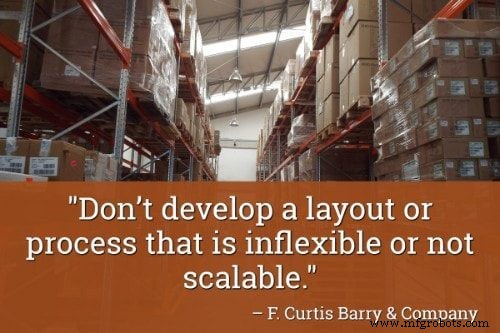
25。倉庫のレイアウト設計は、柔軟性と拡張性の両方を備えている必要があります。 「ビジネスまたはフルフィルメントモデルに対する未知の将来の変更を計画することは、施設と運用に計画外の変更を加えるための不必要なコストを回避するために必要です。柔軟性がない、またはスケーラブルでないレイアウトやプロセスを開発しないでください。効果的な倉庫レイアウトプロセスを開発する方法については、こちらをご覧ください。」 –倉庫レイアウトの設計原則 、F。Curtis Barry&Company; Twitter:@FCurtisBarryCo
26。アクティビティレベルとストレージ要件は、理想的な倉庫レイアウトを決定するために使用できる2つの重要な要素です。 「倉庫を設計する方法は、施設の数だけあります。組織の特定のニーズに基づいて、スペースは同じ業界にサービスを提供する倉庫とは大幅に異なる場合があります。新しいスペースに移動する場合でも、現在のレイアウトを更新する場合でも、伝達できる最も重要な情報の1つは、運用の全体的なアクティビティレベルとストレージ要件です。
- 低アクティビティ/低ストレージ要件–手動処理が標準である小規模な操作でよく見られます。
- 高アクティビティ/低ストレージ要件–ストレージオーバーフローが最小限の単一のフォワードピッキングエリアが特徴です。
- 低アクティビティ/高ストレージ要件–多くの場合、マルチレベルの高密度ストレージを必要とする手動または半手動のピッキング手順。
- 高アクティビティ/高ストレージ要件–大規模な流通センターに典型的なこれらのペースの速い施設は、自動マテリアルハンドリングシステムと大規模なストレージ容量に大きく依存しています。
「加熱、冷却、湿度の制御も、倉庫の設計に大きな影響を与える可能性があります。保管場所、十分な通路スペース、指定された受け取りおよび出荷エリアなど、より一般的な設備を必要とするものもあります。適切な冷蔵スペース、冷蔵要件、および湿度制御機器で生鮮食品を保護する必要があるものもあります。」 –倉庫設計サービスを最大限に活用するためのガイド 、RackExpress; Twitter:@rackexpress
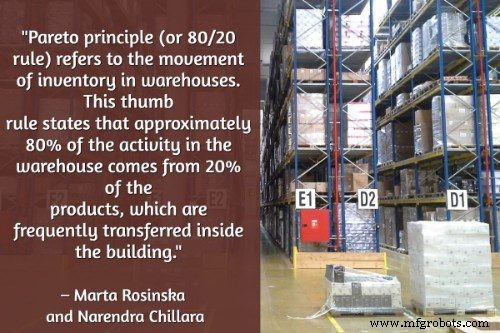
27。パレートの法則は、倉庫内の在庫の移動に適用されます。 「さまざまな倉庫で、さまざまな保管方法とさまざまなタイプのラックまたはメザニンが使用されています。使用可能なスペースを最大化するには、さまざまなタイプのストレージシステムの組み合わせが非常に重要です。貯蔵設備の貯蔵は、家畜の移動に基づいて選択されます(Ten Hompel et al。、2007)。
「パレートの法則(または80/20の法則)とは、倉庫内の在庫の移動を指します。この経験則によると、倉庫での活動の約80%は、建物内で頻繁に転送される製品の20%から発生します。次の15%のアクティビティは、30%の在庫管理単位(SKU)から得られます。これは、移動率が平均として定義されます。 Finally, 5% of the activity comes from 50% of the inventory, which are stored in a slow manner. By separating the fast, medium and slow-moving products within the plant and increasing access to products requiring the highest activity, the throughput can be increased significantly.
“Moreover, by facilitating access to these products, additional time can be gained to transfer the products inside the building (Ackerman, 2013).
“Parts with high turnover are usually stored in warehouses with high volumes using pallet racking with standard width passes. Companies that have a reach truck can store products with a high turnover in places where there are narrow aisles. Products with an average circulation are more suitable for storage in narrow aisles. Lastly, it is suggested to store slow-moving products in a very narrow aisle by trucks with rising cabin. However, this is only theory that aim to support the decision how to store goods. Depending on the situation and needs, the scenario might be different (Ten Hompel et al., 2007).” – Marta Rosinska and Narendra Chillara, Layout design planning of a logistics center: A study on space utilization after merger of two warehouses , Department of Technology Management and Economics, Division of Supply and Operations Management, Chalmers University of Technology; Twitter:@chalmersnyheter
28。 Unique inbound shipment characteristics can play a role in optimal warehouse design. “Inbound shipment characteristics also play a large role in warehouse design. The ideal inbound shipment? A full palletload from a pre-certified vendor, with a single SKU ready for immediate putaway.
“At the other end of the spectrum, chemical or pharmaceutical materials may require lab testing before they can be accepted for putaway into inventory. This means product must be quarantined in a separate receiving area while it awaits testing.” – Lisa Harrington, Designing the Perfect Warehouse , Inbound Logistics; Twitter:@ILMagazine
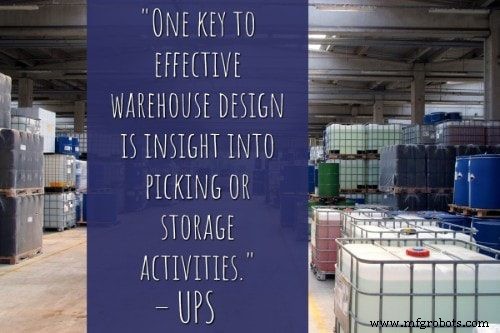
29. Don’t over-complicate picking processes by overemphasizing storage needs. Instead, your goal is to find the perfect balance between the two. “Because warehouses are a buffer for inbound shipments from suppliers and outbound orders to customers, the nature of warehousing often changes from storage to transaction. In addition, overseas sourcing increases the need for warehousing–increasing its importance in the supply chain.
“One key to effective warehouse design is insight into picking or storage activities. A large warehouse space can meet storage needs but complicate picking processes. You need to find a balance for the design of your warehouse.” – Warehouse Design and Layout , UPS; Twitter:@UPS
30. Allow ample space for goods-in. “The goods receiving area of your warehouse is generally a hive of activity, which all too often is crammed into an inadequate space for the purpose.
“While it may seem counterintuitive to give up floor and racking space to expand the goods-in section of your warehouse, releasing a larger floor area here can often lead to greater overall warehouse layout efficiency—and therefore reduced operating costs.” – Rob O’Byrne, 4 Ways to Improve Warehouse Layout Efficiency and Save Costs , Logistics Bureau; Twitter:@LogisticsBureau
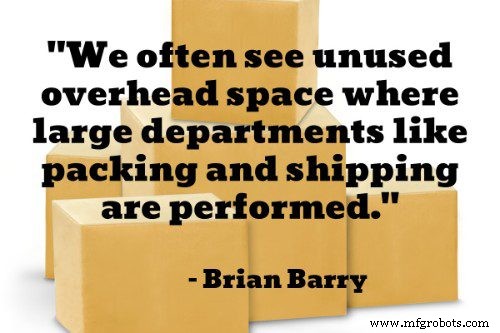
31. Analyze department space to tap into unused overhead space. “Identify functions that do not require high ceilings in areas where lower stacking heights are dictated by the clear height. We often see unused overhead space where large departments like packing and shipping are performed.
“Look up and make sure you’re using all the vertical space available. Investigate storage media to take advantage of your clear span height. How much cubic feet of vertical space is not being used? Be sure to know how your design might impact your sprinkler design and fire code.” – Brian Barry, 15 Ways to Improve Warehouse Space Utilization , Multi-Channel Merchant; Twitter:@mcmerchant
32。 Give forklift operators as wide a path as possible. “Space is also key in maintaining an efficient environment for forklift operation. That doesn’t simply refer to the square footage of the warehouse. It’s possible to have a very large facility with little operable space. The idea here is to provide as a wide of a path as possible for your forklift operators. One easy way to do this is to keep all stored products and packages up against a wall. If your inventory and/or space limitations require the construction of aisles, then make sure you have plenty of space between rows for a forklifts to maneuver without being cramped. The width between aisles will largely depend on the type of forklifts you are using as models vary in terms of turning radius, elevation and reach. Once you’ve identified the forklift models in your warehouse, construct your aisles accordingly. This will not only speed up work flow, it will also go a long way in avoiding accidents..
“Width between aisles isn’t the only important consideration in the layout of your aisles. Logical and proper labeling is also key. As much as possible, try to stack items of a similar kind or category in the same aisle, and make sure each aisle is clearly labeled so employees know which items can be found there. This will avoid hours of confusion and backtracking that can result when employees are not sure where to find specific inventory items. Creating short cuts through aisles can also help to streamline storing and delivery. Putting gaps in the middle of aisles will allow employees to make a direct a path to the items they need without having to walk or drive forklifts around entire aisles to get there.” – Tom Reddon, Best Practices for an Efficient Warehouse Layout , National Forklift Exchange; Twitter:@TomReddon
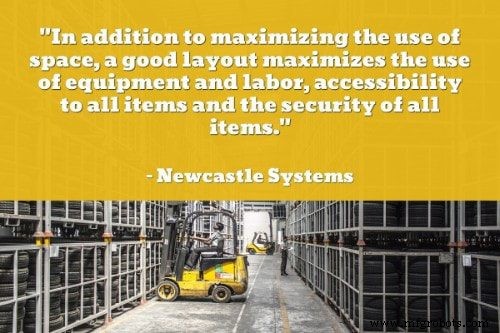
33. An optimized warehouse layout not only maximizes the use of horizontal and vertical space, but also equipment and labor. “The optimal layout factors both the floor space and the vertical space available for use. In addition to maximizing the use of space, a good layout maximizes the use of equipment and labor, accessibility to all items and the security of all items. Using forklifts that reach the roof of the warehouse allows for a configuration that maximizes both the horizontal and vertical space.
“The complementary solution is to ensure that the highest-selling inventory is easily accessible by placing it at the most accessible point.” – Top Five Warehouse Management Problems and How to Fix Them , Newcastle Systems; Twitter:@NewcastleSys
34。 Review global layout efficiency. “It’s always been like this and to complicate to change. This is the common comments. Start looking at the global warehouse configuration and think of those 3 basic points:space utilization, productivity and global operation control &management. Look at opportunity to change considering those points:aisle orientation, product flow, incoming and outgoing operation, location of services area (employee access, building services, working area (repack etc)), fix equipment location (stretch wrap, scale, packing tables, etc). Look at measuring productivity per sector or operation and evaluate time consumption and finally review your WMS performance.” – Albert Goodhue, Warehouse Layout Optimization:Some basics steps , GCL Logistics &Supply Chain Consulting
Warehouse Layout Design Ideas
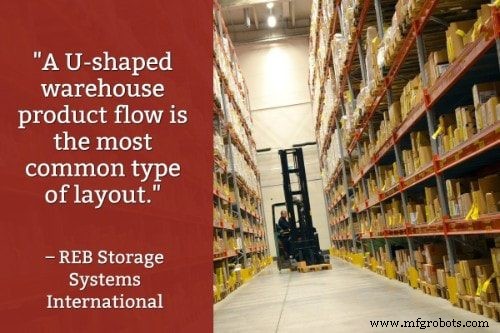
35. A U-shaped product flow is the most common type of warehouse layout, but that doesn’t mean it’s the best layout for your business. “A U-shaped warehouse product flow is the most common type of layout. In this layout the shipping and receiving docks are located next to one another, offering shared utilization of dock resources such as personnel and material handling equipment. This layout also minimizes product handling, offering high cross-docking capability.” – Warehouse Layout &Product Flow Options , REB Storage Systems International; Twitter:@REB_Storage
36。 If you need enhanced security, an I-shaped or L-shaped warehouse layout may be better suited to your needs. “I-shaped warehouse product flow and L-shaped warehouse product flow, also known as through flow, are similar in that the shipping and receiving areas are located on different sides of the warehouse. As a result, these require more available warehouse space than U-shaped layouts.
“These layouts can be beneficial for certain operations. For example, warehouses that require heightened security can benefit from the separate ‘in’ and ‘out’ areas. I-shaped and L-shaped layouts can also provide larger sorting and storage areas for both shipping and receiving docks as well as allowing for isolated monitoring of each function.” – Warehouse Layout &Product Flow Options , REB Storage Systems International; Twitter:@REB_Storage
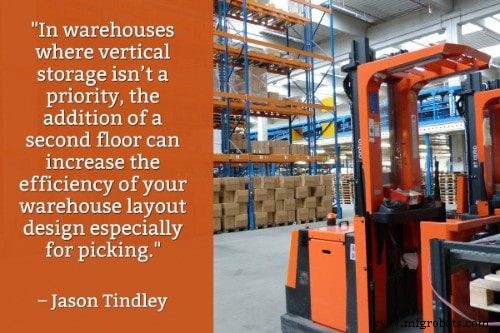
37. Consider adding a floor. “In warehouses where vertical storage isn’t a priority, the addition of a second floor can increase the efficiency of your warehouse layout design especially for picking. Mezzanine floors offer a way to maximize warehouse space without the high costs of complete renovation. These types of floors are ideal for small warehouses looking to expand their space due to increased product demand.” – Jason Tindley, How To Design An Efficient Warehouse Layout In 10 Easy Steps , Logistics Planning Consultants; Twitter:@LPCINT
38。 Incorporate cross aisles. “If all of the aisles in your warehouse are long and continuous, it could make getting from one place to another extremely difficult. Increase efficiency by creating a grid of cross aisles.” – 6 Smart Tips on How to Improve Your Warehouse Layout Design , Porta Power, Inc.; Twitter:@PortaPowerInc
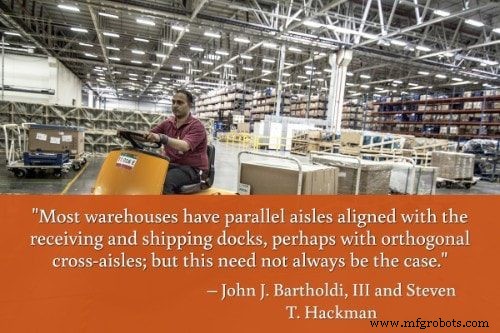
39. A fishbone layout, featuring angled aisles, is touted by some experts. “Most warehouses have parallel aisles aligned with the receiving and shipping docks, perhaps with orthogonal cross-aisles; but this need not always be the case. Kevin Gue of Auburn University and Russ Meller of the University of Arkansas [23] have argued that travel times can be reduced by up to 20% by reorienting some aisles and including some angled cross-aisles, which they call a fishbone layout. The overall warehouse must be slightly larger to compensate for the space lost to the additional aisles; but this is more than made up for by the efficiency of more direct travel to or from a centralized point of receiving and shipping.
“It is possible to take advantage of this more direct travel if most pallet movement is to or from the central dispatch point. But if a forklift finishes putting away a pallet and then must retrieve another, the orientation of the aisles of the fishbone arrangement may not help at all, and indeed may be an impediment. Nevertheless, this possibly inefficiency seems to be more than made up for by the direct travel to and from the central dispatch point.” – John J. Bartholdi, III and Steven T. Hackman, Warehouse &Distribution Science , Release 0.94, The Supply Chain and Logistics Institute, School of Industrial and Systems Engineering, Georgia Institute of Technology (Latest version, Release 0.98, can be downloaded from Warehouse-Science.com)
40. Ensure that processes are positioned closely to other processes and functions they rely on. “The overall layout of the warehouse is an important factor in the optimization of operations. The flow throughout should generally move in either a line or a ‘U’ shape. In this facility there is a single door for both incoming shipments and outgoing orders, so the flow should be in a circular manner. Beginning with reception from the manufacturer, to putaway and replenishment, to order picking and fulfillment, and finally concluding with packaging and delivery to the outgoing shipper, each process should be in close proximity to those it relies upon.” – Tobiah R. Master, Warehouse Redesign of a Facility Layout, Racking System, and Item Classification at Sunrize Tackle, Inc. , California Polytechnic State University; Twitter:@CalPoly
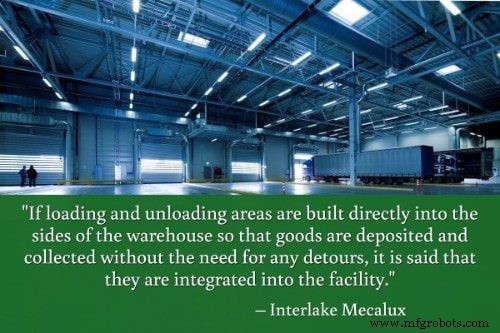
41. If space is available, integrated loading and unloading areas can offer greater load handling speed. “If loading and unloading areas are built directly into the sides of the warehouse so that goods are deposited and collected without the need for any detours, it is said that they are integrated into the facility. The main advantage of this is the greater load handling speed, which means it is preferable to non-integrated options if there is sufficient space for it.
“Trucks are connected to the warehouse via the docks and these docks can be:
- Docks separated by an intermediate platform: They are appropriate when this separation is advisable as determined by the nature of the goods or the need to maintain the internal warehouse environment or when there are safety issues relating to the material stored. A typical example of applying this type of separated dock is for cold chambers, where cold loss could occur if a flush dock is used with an access door and where this must be avoided at all costs. Yet there are many other circumstances in which this design is preferable, particularly when the safety of the warehouse could be compromised.
- Flush docks: They allow trucks to back right up to the warehouse wall. To avoid affecting the internal environment of the facility, access doors must have, as a minimum, a hermetically sealed system. This seal can be metal or created through the use of a dock shelter.” – Warehouse layout design , Interlake Mecalux; Twitter:@IKMXus
42。 Design a variety of location sizes to accommodate a greater variety of storage needs and take advantage of all available space. “We see instances where one or two cases stored in a location designed for a full pallet. It is necessary to have a variety of location sizes to accommodate the variety of storage needs on a product by product basis. Another waste of space occurs in picking areas where only the front portion of the pick slot is utilized with empty space left behind. The slotting process should take care of this, but we see it a lot in many warehouses. Make sure the pick slot is designed to fit the cubic velocity of the SKU. It is impossible to attain 100% of capacity on a daily basis but the higher % you can maintain in established locations, the more space you will have available.” – Warehouse Layout and Design Ideas to Begin Improving DC Capacity , F. Curtis Barry &Company; Twitter:@FCurtisBarryCo
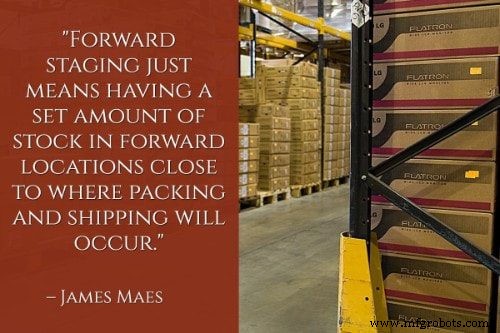
43. Incorporate forward locations to streamline picking efficiency. “Another way to optimize picking is by using forward locations. Forward locations can be a huge time saver, especially with more popular or high-volume items. The idea is to minimize trips to more remote locations in the warehouse at the same time that you minimize the distance a picker has to travel to get an item.
“Forward staging just means having a set amount of stock in forward locations close to where packing and shipping will occur. When an order for one of these items comes in, an employee can choose items from the forward location quickly. As the quantities in the forward location get low, replenishment stock from elsewhere in the warehouse (or from a less expensive off-site location) can then be brought forward.” – James Maes, 8 Tragically Common Mistakes in Warehouse Setup , Infoplus Commerce; Twitter:@infopluscommerc
44. Rethink your rack and shelving solution, and expand vertically. “Rather than expand the footprint of your warehouse, consider better use of vertical space. Adding taller storage units and the right equipment to pick and store material can help you keep more in the same square footage, rather than adding expansion costs. In addition, think about the type and variety of shelving used. Storing small items on pallet racks wastes space, and makes it easy to misplace items. Rather than using the same racks throughout your warehouse, you may need various types of shelving for different materials. Also, try using standardized bins to help keep shelves neat and orderly.” – Danny Hammack, Five simple ways to improve warehouse efficiency , CIPS; Twitter:@supplymgmt
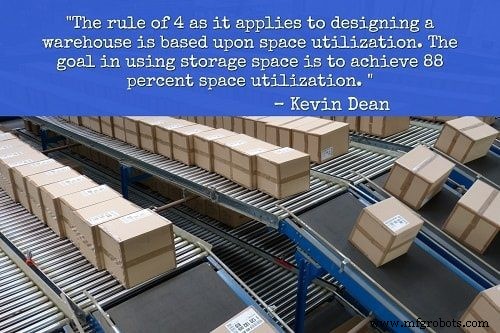
45。 Use the Rule of 4 and aim for 88 percent space utilization. “The rule of 4 as it applies to designing a warehouse is based upon space utilization. The goal in using storage space is to achieve 88 percent space utilization. The reason for this is that a higher utilization requires too many aisles to achieve the storage slot space utilization, and therefore is wasteful. A lower utilization causes the warehouse to have honeycombing, which is the phenomenon of a warehouse that has pallet locations filled with half empty pallets – the locations are full and locked up, but the actual storage space contains more air than product.” – Kevin Dean, How to design a space-efficient and productive new warehouse , Raymond Handling; Twitter:@RaymondHandling
46. Other experts suggest that operations run best at about 85% full. A facility under 85% full reduces potential profit. “Inventory is a huge factor in determining an optimized layout for your warehouse. The type of inventory you distribute, the amount, and the length of time the product is in the warehouse are all things that should be taken into consideration during the planning process. Things like the inbound and outbound process as well as the way the items are stored should also be considered. Aside from the type of inventory, you should also consider how much you are going to keep available at your warehouse at any time. Operations run best at about 85% full, anything more than that will be less efficient and anything less would reduce your potential profit. Projected order statistics along with past data can help determine an optimized solution.” – Optimize Your Warehouse Layout , Supply Chain Link; Twitter:@NFIindustries
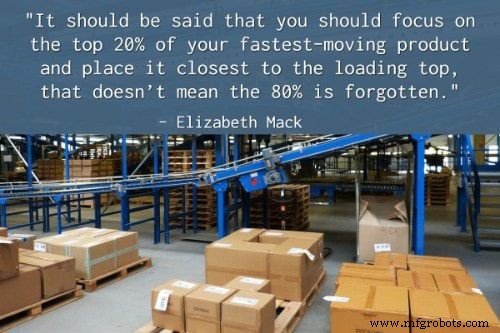
47. Use high-density shelving to organize slow-moving inventory. “It should be said that you should focus on the top 20% of your fastest-moving product and place it closest to the loading top, that doesn’t mean the 80% is forgotten. This is where high-density shelving systems come into play.
“In particular, high-density shelving systems are great for storing slow-moving product. Often times, businesses are so focused on their fast-moving product that slower-moving product is put on the wayside.
“What this type of shelving system does is double your storage capacity and make it easy and efficient for employees to retrieve inventory. Its accessibility and space-saving features are the reasons why we added it to the list.” – Elizabeth Mack, Warehouse Solutions You May Need to Make Your Facility More Efficient , Specialized Storage Solutions
48. Incorporate the four functional warehouse zones in your layout. “The top 4 functional warehouse zones identified using forecasting and projections are storage, yard/dock, picking and VAS/kitting zones. To identify the proper size of the storage area evaluate key factors such as project inventory levels, temperature requirements, product dimensions, fulfillment rules, flow through rates and more. All of these factors will play a part in determining proper storage layout. Data must also be collected to determine yard and dock door requirements. Too little staging space and dock doors can create a significant bottleneck, slowing down warehouse productivity. When determining picking and shipping size and location identifying your picking strategy will help to make these decisions. Consider the space requirements needed for all types and which will work best for your available resources.” – Cold Storage Warehouse Best Practices:Warehouse Layout Optimization , Datex; Twitter:@Datexcorp
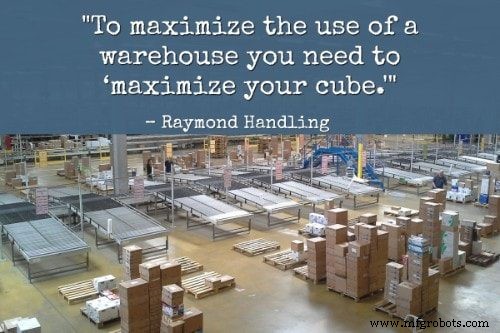
49. Maximize your cube. “To maximize the use of a warehouse you need to ‘maximize your cube.’ You need to take advantage of all of the vertical space that you have available. With a conventional fire protection system you can stack products up to 18” below the fire sprinkler heads. In an ESFR (Early Suppression, Fast Response) system this distance is 36”. You may need to reconfigure your existing storage system to take advantage of this space but it could be worth the effort.” –
How to optimize your existing warehouse space , Raymond Handling; Twitter:@RaymondHandling
50. Keep special processing areas under control. “Create space-saving layouts for special processing areas such VAS and returns. According to Elenbark [Bill Elenbark, senior engineer for the supply chain consulting firm TranSystems], special processing areas have a tendency to creep in size and spread out over larger areas than are required. It may be high time to take a closer look and consider making space-saving changes. If a lot of pallets are sitting on the floor, consider adding a short section of pallet rack to take advantage of cube. Carousels can be used as buffers to accumulate processed returns before returning them to inventory.” – Maida Napolitano, Space Optimization:Mission Impossible? , Logistics Management; Twitter:@LogisticsMgmt
Products and Tracking Solutions from Camcode:
- Rack Location Labels
- バーコードステッカー
- Barcode Warehouse Labels
- UIDラベリング
- Inventory Labels
- 通路の標識
- Equipment ID Tags
- Custom Warehouse Signs
- 箔ラベル
産業技術



